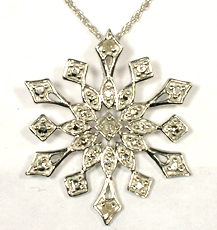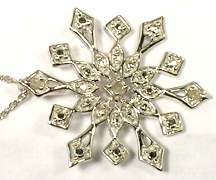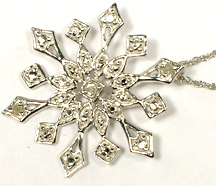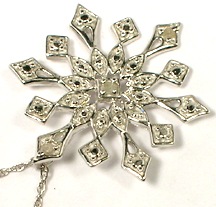















NEW Handcrafted Sterling Silver Diamond-Accented Snowflake Motif Pendant.
PENDANT SIZE: 26 millimeters (over 1 inch) in diameter, accented with three 1½mm diamond accents (total gemstone weight about 1/20th carat). All measurements approximate. Includes 18 inch sterling silver chain.
CHAIN NOTE: We have many other sterling silver chains available which would fit this pendant, ranging from 16 to 30 inches. We also have available chains in 14kt gold fill and 14kt solid gold.

DETAIL: There was but one source of diamond in the ancient world…India, where written records pertaining to diamond date back to 400 B.C. The best Indian diamonds originated from the Majhgawan pipe, near Panna, India. Perhaps the earliest symbolic use of diamonds was as the eyes of Hindu devotional statues. The diamonds themselves were thought to be endowments from the gods and were therefore cherished. The point at which diamonds assumed their divine status is not known, but early texts indicate they were recognized in India since at least 400 B.C. The ancient Greeks believed diamonds were tears of the gods; and it is from the Greek word adamas, "untameable" or "unconquerable", referring to its hardness, that the word “diamond” is derived. The ancient Romans believed that diamonds were splinters of fallen stars. The presence of diamond in Rome is established by the writings of the Roman Historian and Naturalist, Pliny the Elder (23-79 A.D.).
Here are three such “star splinters”, a nice quality snowflake motif pendant, solid sterling silver (not cheap electroplated silver), accented with THREE 1½ millimeter diamonds and were handcrafted by an artisan. Though the pendant is cleverly and very convincingly crafted to appear to contain twenty-five diamond accents, we want to emphasize that there is in reality only three diamond accents; one in the middle, and then one more both directly above and below the middle. However except to very close examination, the pendant appears to contain twenty-five diamond accents, and the appearance is quite convincing. You have to examine the pendant very intently to realize that all of the prong-set “diamond” accents (except for three) are in fact merely metal made to look like prong-set diamond accents.

In any event, the pendant is new, and is very handsome and appealing, and does contain three genuine 1½ millimeter diamond accents weighing approximately 0.05 carats (total gemstone weight). Under magnification the gemstones show the unmistakable characteristics of having been hand crafted. The coarseness of the handcrafted finish is considered appealing to most gemstone collectors, and is not considered a detriment, or to detract from the value of a gemstone. These characteristics are not only expected of hand-finished gemstones, most serious collectors consider such gemstones more desirable, possessed of greater character and uniqueness when compared to today's cookie-cutter mass-produced machine-faceted gemstones. Unlike today’s computer controlled machine produced gemstones that approach flawlessness in a perfect finish, the cut and finish of a handcrafted gemstone such as these is the cultural legacy passed onwards by artisans who lived centuries ago.
The diamonds have great luster and sparkle, and are transparent, but they are not entirely flawless. True, the blemishes they possess are virtually invisible to the naked eye, and the gemstones can be characterized, to use trade jargon, as "eye clean". However magnified as they are here in these photo enlargements you might be able to just barely pick out a blemish or two within the stones. Of course the same may said about almost any natural gemstone. An absolutely flawless gemstone simply is not the rule in nature. Most absolutely flawless gemstones will upon close examination be revealed to be synthetic. You might also notice under magnification occasional irregularities in the cut and finish. Naturally these characteristics are absolutely to be expected with hand-finished gemstones. However for most, the unique nature and character of handcrafted gemstones such as this more than makes up for minute blemishes and cutting or faceting imperfections, which by and large of course, are (if at all) only visible under high magnification.

DIAMOND HISTORY: In the ancient world there was only one source of diamonds…India. Bombay remains today one of the world’s great diamond cutting centers (along with New York, Tel Aviv, and Antwerp). Over 800,000 cutters are employed in the city of Bombay alone; cutting 90% of the world’s diamonds. The best Indian diamonds originated from the Majhgawan pipe, near Panna, India, which was discovered in 1827. However India is no longer a big producer of mined diamonds, producing only about 20,000 carats a year. Australia produces 2,000 times more diamonds each year – about 40 million carats a year; followed by 20 million carats a year for the Congolese Republic, 15 million carats a year for Botswana, and 10 million carats a year each for Siberia and South Africa. However this region of India did produce some of the world’s greatest diamonds, including the Great Mogul (793 carats), the Regent (410 carats), the Nizam (340 carats), the Orloff (194 carats), the Kohinoor (132 carats), and the Hope or Blue Tavernier (112 carats).
The traditional Indian supplies of diamonds which had fed the appetites of the ancient world for thousands of years were almost exhausted when enormous new alluvial deposits of diamonds were discovered in 1725 in Brazil, followed by the staggering discoveries of 1870 in South Africa. Perhaps the earliest symbolic use of diamonds was as the eyes of Hindu devotional statues. The diamonds themselves were thought to be endowments from the gods and were therefore cherished. The point at which diamonds assumed their divine status is not known, but early texts indicate they were recognized in India since at least 400 B.C. The word most generally used for diamond in Sanskrit was vajra, or "thunderbolt," and the possession of diamond was according to ancient Hindu texts thought to bring, “happiness, prosperity, children, riches, grain, cows and meat. (As well) he who wears a diamond will see dangers recede from him whether he (is) threatened by serpents, fire, poison, sickness, thieves, flood or evil spirits."

The ancient Greeks believed diamonds were tears of the gods; and it is from the Greek word adamas, "untameable" or "unconquerable", referring to its hardness, that the word “diamond” is derived. The ancient Romans believed that diamonds were splinters of fallen stars. The presence of diamond in Rome is established by the writings of Pliny the Elder (23-79 A.D.). Unfortunately according to Pliny, “these stones are tested upon the anvil, and will resist the blow to such an extent as to make the iron rebound and the very anvil split asunder." One can only imagine the numbers of genuine diamonds smashed into splinters by this ill-advised test. However even diamond splinters were valued by the Romans who used diamond points set into iron scribes to engrave sapphires, cameos, and intaglios. Even early Chinese references to diamond cite its coming from Rome in iron scribes. Chinese interest in diamond was strictly as an engraving or carving tool, primarily for jade, or as a drill for beads and pearls.
In western culture, diamonds are the traditional emblem of fearlessness and virtue. Though most of the world’s diamonds are cut in Bombay, over 90% of the world’s rough diamonds are traded in Antwerp, Belgium. Between the 13th and 15th centuries the world’s diamond center had been Bruges; then Antwerp until the city’s capture by the Spanish in 1585 A.D.; then Amsterdam through the early 19th century, then back to Antwerp. The Portuguese colony of Goa was the point of origin for diamonds from India, the trade route developing from Goa to Lisbon to Antwerp and thus cutting out the traditional Arabic middle men. Small numbers of diamonds begin appearing in European regalia and jewelry in the 13th century, set as accent points among pearls in splendidly wrought gold. Louis IX of France (1214-70 A.D.) decreed that diamonds were to be reserved for royalty alone, an indication of the rarity of diamonds and the value conferred on them at that time.

The history of diamond cutting can be traced to the late Middle Ages before which time diamonds were enjoyed in their natural octahedral state. At the time, diamond was valued chiefly for its brilliant lustre and superlative hardness. The most common (“table”) cut diamond would appear black to the eye, as they do in paintings of the era. Diamond cutting is believed to have originated in Venice about 1330 A.D. By 1375 A.D. there was a guild of diamond polishers in Nurnberg. About a hundred years later absolute symmetry in the disposition of faceting was introduced and the most common cuts were known as pendeloque or briolette. About the middle of the 16th century, the rose cut was introduced. The first “brilliant cut” was introduced in the middle of the 17th century. By the 16th century as diamonds became larger and more prominent, their popularity had spread from royalty to the noble classes. This was in part a response to the development of diamond faceting, which enhanced their brilliance and fire. By the 17th century diamonds were becoming popular with the wealthy merchant class.
Diamonds occur in a variety of colors - steel, white, blue, yellow, orange, red, green, pink, brown and black. The most common diamonds, and arguably the most sought after (though not the rarest) are pure and colorless. The most common impurity is nitrogen, which if dispersed will give the stone a yellowish tint (but if clustered does not affect the diamond’s color). Diamonds without nitrogen impurities are often colored pink, red, or brown – the color arising from molecular structural anomalies. Blue diamonds are colored by boron impurities. A form of carbon, diamonds are not “forever”, even the Romans demonstrated that they will burn (or decay with heat). However a diamond is likely the oldest thing you will ever own, probably 3 billion years in age, fully two thirds the age of the Earth. Diamonds are carbon crystals that form deep within the Earth under high temperatures and extreme pressures. For instance when as part of “plate teutonics” an ocean floor slides beneath the earth’s crust and into the mantle, entrapped organic carbon may eventually become diamond. They are created at depths generally more than 150 kilometers down into the mantle.

Diamonds are brought back to the surface in a rare form of molten rock (or magma), that originates at great depths, which rises and erupts in small but violent volcanoes. When cooled, just beneath such volcanoes is a carrot-shaped "pipe" filled with volcanic rock, mantle fragments, and embedded diamonds. Diamonds also form as a result of the immense pressures created by meteor impacts. Meteorites also experience impacts themselves and can contain diamonds. And the most ancient meteorite material contains star dust, the remnants of the death of stars. Some of this star dust are very small diamonds and are older than the solar system itself. New studies indicate that they formed more than 5 billion years ago in flashes of radiation from dying red-giant stars into surrounding clouds of methane-rich gas. If you would like to learn more about diamonds, please click here to visit a great web site by the American Museum of Natural History.
SHIPPING & RETURNS/REFUNDS: Your purchase will ordinarily be shipped within 48 hours of payment. We package as well as anyone in the business, with lots of protective padding and containers. All of our shipments are fully insured against loss, and our shipping rates include the cost of this coverage (through stamps.com, Shipsaver.com, the USPS, UPS, or Fed-Ex). International tracking is provided free by the USPS for certain countries, other countries are at additional cost. ADDITIONAL PURCHASES do receive a VERY LARGE discount, typically about $5 per item so as to reward you for the economies of combined shipping/insurance costs. We do offer U.S. Postal Service Priority Mail, Registered Mail, and Express Mail for both international and domestic shipments, as well United Parcel Service (UPS) and Federal Express (Fed-Ex). Please ask for a rate quotation. We will accept whatever payment method you are most comfortable with.
 Please note for international purchasers we will do everything we can to minimize your liability for VAT and/or duties. But we cannot assume any responsibility or liability for whatever taxes or duties may be levied on your purchase by the country of your residence. If you don’t like the tax and duty schemes your government imposes, please complain to them. We have no ability to influence or moderate your country’s tax/duty schemes. If upon receipt of the item you are disappointed for any reason whatever, I offer a no questions asked 30-day return policy. Send it back, I will give you a complete refund of the purchase price; 1) less our original shipping/insurance costs, 2) less any non-refundable eBay fees. Please note that though they generally do, eBay may not always refund payment processing fees on returns beyond a 30-day purchase window. So except for shipping costs and any payment processing fees not refunded by eBay, we will refund all proceeds from the sale of a return item. Obviously we have no ability to influence, modify or waive eBay policies.
Please note for international purchasers we will do everything we can to minimize your liability for VAT and/or duties. But we cannot assume any responsibility or liability for whatever taxes or duties may be levied on your purchase by the country of your residence. If you don’t like the tax and duty schemes your government imposes, please complain to them. We have no ability to influence or moderate your country’s tax/duty schemes. If upon receipt of the item you are disappointed for any reason whatever, I offer a no questions asked 30-day return policy. Send it back, I will give you a complete refund of the purchase price; 1) less our original shipping/insurance costs, 2) less any non-refundable eBay fees. Please note that though they generally do, eBay may not always refund payment processing fees on returns beyond a 30-day purchase window. So except for shipping costs and any payment processing fees not refunded by eBay, we will refund all proceeds from the sale of a return item. Obviously we have no ability to influence, modify or waive eBay policies.
 ABOUT US: Prior to our retirement we used to travel to Eastern Europe and Central Asia several times a year seeking antique gemstones and jewelry from the globe’s most prolific gemstone producing and cutting centers. Most of the items we offer came from acquisitions we made in Eastern Europe, India, and from the Levant (Eastern Mediterranean/Near East) during these years from various institutions and dealers. Much of what we generate on Etsy, Amazon and Ebay goes to support worthy institutions in Europe and Asia connected with Anthropology and Archaeology. Though we have a collection of ancient coins numbering in the tens of thousands, our primary interests are ancient/antique jewelry and gemstones, a reflection of our academic backgrounds.
ABOUT US: Prior to our retirement we used to travel to Eastern Europe and Central Asia several times a year seeking antique gemstones and jewelry from the globe’s most prolific gemstone producing and cutting centers. Most of the items we offer came from acquisitions we made in Eastern Europe, India, and from the Levant (Eastern Mediterranean/Near East) during these years from various institutions and dealers. Much of what we generate on Etsy, Amazon and Ebay goes to support worthy institutions in Europe and Asia connected with Anthropology and Archaeology. Though we have a collection of ancient coins numbering in the tens of thousands, our primary interests are ancient/antique jewelry and gemstones, a reflection of our academic backgrounds.
Though perhaps difficult to find in the USA, in Eastern Europe and Central Asia antique gemstones are commonly dismounted from old, broken settings – the gold reused – the gemstones recut and reset. Before these gorgeous antique gemstones are recut, we try to acquire the best of them in their original, antique, hand-finished state – most of them originally crafted a century or more ago. We believe that the work created by these long-gone master artisans is worth protecting and preserving rather than destroying this heritage of antique gemstones by recutting the original work out of existence. That by preserving their work, in a sense, we are preserving their lives and the legacy they left for modern times. Far better to appreciate their craft than to destroy it with modern cutting.
 Not everyone agrees – fully 95% or more of the antique gemstones which come into these marketplaces are recut, and the heritage of the past lost. But if you agree with us that the past is worth protecting, and that past lives and the produce of those lives still matters today, consider buying an antique, hand cut, natural gemstone rather than one of the mass-produced machine cut (often synthetic or “lab produced”) gemstones which dominate the market today. We can set most any antique gemstone you purchase from us in your choice of styles and metals ranging from rings to pendants to earrings and bracelets; in sterling silver, 14kt solid gold, and 14kt gold fill. When you purchase from us, you can count on quick shipping and careful, secure packaging. We would be happy to provide you with a certificate/guarantee of authenticity for any item you purchase from us. There is a $3 fee for mailing under separate cover. I will always respond to every inquiry whether via email or eBay message, so please feel free to write.
Not everyone agrees – fully 95% or more of the antique gemstones which come into these marketplaces are recut, and the heritage of the past lost. But if you agree with us that the past is worth protecting, and that past lives and the produce of those lives still matters today, consider buying an antique, hand cut, natural gemstone rather than one of the mass-produced machine cut (often synthetic or “lab produced”) gemstones which dominate the market today. We can set most any antique gemstone you purchase from us in your choice of styles and metals ranging from rings to pendants to earrings and bracelets; in sterling silver, 14kt solid gold, and 14kt gold fill. When you purchase from us, you can count on quick shipping and careful, secure packaging. We would be happy to provide you with a certificate/guarantee of authenticity for any item you purchase from us. There is a $3 fee for mailing under separate cover. I will always respond to every inquiry whether via email or eBay message, so please feel free to write.
